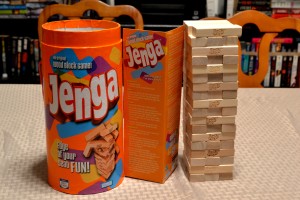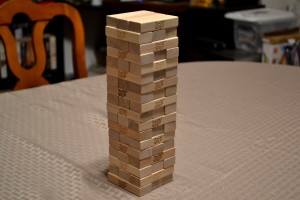“Jenga” was created in the early 1970’s by one Leslie Scott, whose focus at the time was coming up with games that she could play with her family. “Jenga” also means “to build” in Swahili (your history lesson for today). For those of you who have never played this game before, you have now chance to play the game at casino daisy and win real cash, that’s exactly what you’ll be doing…though you’ll be deconstructing and possibly wrecking things in the process. For the benefit of those who have never had the fortune of playing “Jenga”, allow me to quickly outline the components and rules before launching into the review. It’s worth noting that there are a few different versions of “Jenga” on the market, so the content featured below may differ slightly from what you might see in your travels.
Components
Blocks – The game comes with fifty-four wooden blocks, each shaped like a rectangular prism.
Stacking Sleeve – The stacking sleeve not only lists the rules, but assists players in building the tower during the game setup process.
All of the above comes in a bright orange, cylinder-shaped carrying case.
Setup & Gameplay
To set up the tower, a designated player will begin by laying three blocks side by side on the stacking sleeve. Then directly on top of these three blocks follows three more, but they’ll be facing in the opposite direction (via right angles). The player will continue stacking the blocks (assisted by the stacking sleeve) until all of the blocks have been placed. To reward that player for all of their hard work, they’ll get to go first.
On a player’s turn, they’ll choose any block below the top level, pull it out, and attempt to stack it on the very top of the tower. When placing the block on the top level, it’s important that the player observe the “right angle” pattern as explained during setup. It’s also important to finish a three-block story before starting a new one. After placing the block, that player must wait ten seconds before their turn officially ends. Of course, if the next player is confident that the tower will hold, they can choose to take their turn immediately.
The game ends when the tower falls, even if it’s only a minor kerfuffle. The player who went directly before the player who caused the tower to topple wins the game!
The Review
I’ll opt to keep this review short and sweet, due to how easy this game is to pick up and play. The wood blocks were of good quality and solid to boot. The stacking sleeve that contains the instructions is fairly thick and holds up well when you’re traveling with the game. The case itself is surprisingly big, which can be annoying when you’re trying to fit it into a closet filled with square-shaped board game boxes. A rope is built into the case, allowing it to serve as a convenient travel container.
The game itself will certainly test your physical dexterity, as well as your mental prowess. Before removing a piece, it’s vital to see how the tower is fairing in regards to which blocks favor weight and balance. As the game progresses, some pieces will be easier to remove then others and it can be a real challenge to keep up with other competent players. There’s also a level of tension associated with the game, mainly due to how long it can take to set up the game in the first place. I suppose after spending the time you took in building the tower, it’s easy to become invested and thus that “foreboding doom” feeling becomes that much more real.
While the game certainly favors those who think before they act, it’s family-friendly enough to appeal to gamers of all ages. It’s fun and easy to play, making it a great party game or something that you could bust out on family game night if time is limited. “Jenga” can also be played solo, if you are in the mood to test your physical and mental reflexes. My only reservation is that the game may stress out the already high-strung, so buyer beware. If you haven’t jumped onboard the “Jenga” train yet, I highly recommend that you do…you won’t be disappointed.
Final Verdict: 9/10
—


